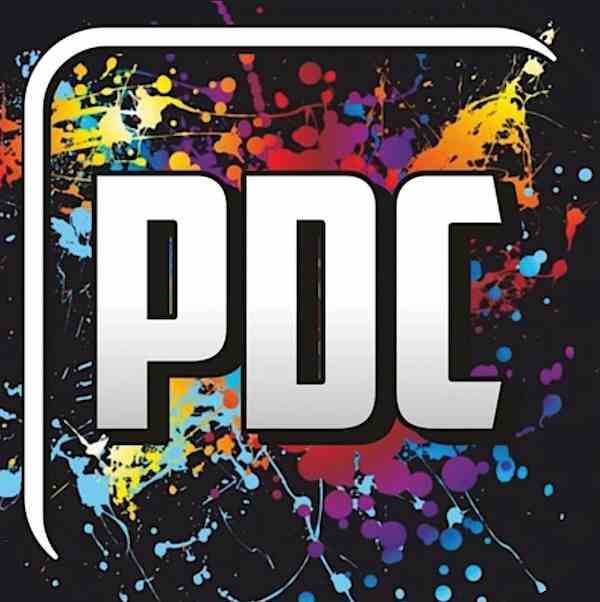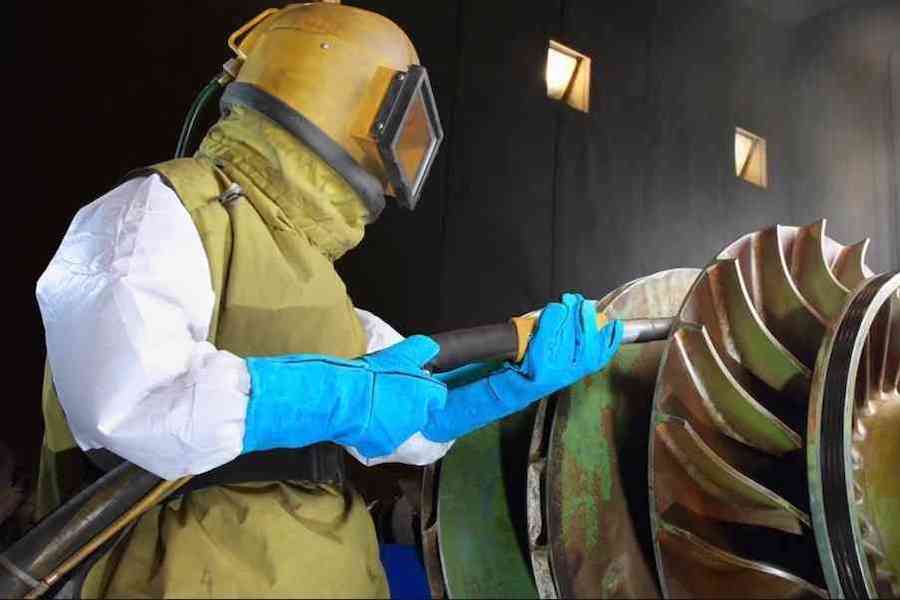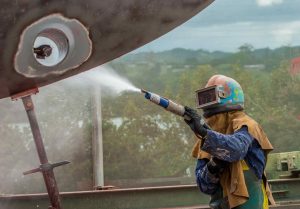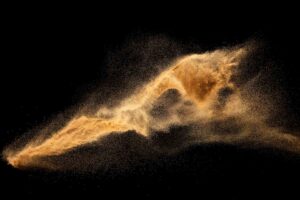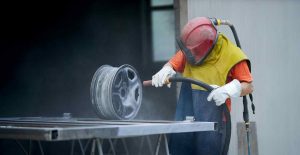Over time, wear and tear can take a significant toll on metal surfaces. Shot blasting is an efficient way to remove rust, corrosion and otherwise stubborn coatings. It leaves the metal clean and free of imperfections, helping to extend the lifespan of metal components, improving their performance and enhancing their appearance.
Shot blasting can be a way to restore metal to an optimal condition, meaning that objects and equipment don’t need to be replaced. This can save you money and reduce the amount of waste materials generated.
Shot blasting is a widely used surface preparation technique across diverse industries. Its versatility and effectiveness as a surface preparation technique has made it indispensable in a range of tasks, from cleaning and strengthening, to polishing various surfaces.
What is shot blasting and why is it such a versatile and highly valued technique across industry?
So what is shot blasting?
Shot blasting is a dynamic surface preparation method that involves propelling abrasive materials, such as steel shots, at a high velocity onto a surface. This is achieved using compressed air or centrifugal force. The abrasive action dislodges contaminants, old coatings, and surface imperfections. The aim is to leave behind a clean, textured surface that is then ready for any subsequent treatments.
The shot blasting process
Shot blasting is a carefully engineered process designed to deliver highly precise results. It begins with the selection of the appropriate abrasive materials. Factors such as the surface material and the desired finish will be key determining factors, along with the size and shape of the workpiece. Once selected, the abrasive material is then loaded into a specialised machine known as a shot blaster.
When the chosen shot makes an impact on the surface, contaminants, rust, scale, and other imperfections are removed, effectively cleaning and preparing the surface. Common abrasive media used in the shot blasting include steel shots, steel grit, aluminium oxide, garnet, and glass beads. Different abrasive media offer different levels of hardness, shape, and size distribution. This allows for precise control over the surface treatment process.
Before shot blasting begins, the surface of the workpiece will be prepared by removing any loose debris, coatings, or contaminants. Proper surface preparation ensures that the shot blasting process can be effective in removing surface imperfections without causing any damage to the workpiece.
When the equipment is set up and the parameters adjusted, the shot blasting process can begin. The workpiece can be repositioned or rotated during the shot blasting process to ensure uniform coverage and consistent results.
The abrasive media impacting the surface of the workpiece generates dust and debris. A dust collection system will usually be employed to capture and remove airborne particles. The spent abrasive media will also be collected for potential reuse, minimising waste, and reducing operational costs.
After the shot blasting operation has been completed, the workpiece will undergo a thorough inspection to ensure that it has the desired surface finish. Any remaining imperfections or contaminants can be addressed through additional shot blasting or surface treatment processes. Quality control measures, such as surface roughness testing and visual inspection, are conducted to verify compliance with industry specifications and standards.
Depending on the application, the shot blasted workpiece may then undergo additional treatments such as coating, painting, or surface finishing to enhance durability, provide added corrosion resistance, or to meet particular aesthetic requirements.
When carried out by a skilled operative, shot blasting can achieve highly successful results across a range of industries.
Does Shot Blasting Remove Rust?
Shot blasting is used widely to remove rust and corrosion. The abrasive action generated by shot blasting breaks down rust layers, exposing clean metal surfaces underneath. Shot blasting can also eliminate any existing coatings or paint, ensuring thorough cleaning and surface preparation. This makes it a valuable technique for preventing and removing rust from metal surfaces across a range of industrial applications.
Is shot blasting safe?
When performed correctly, shot blasting is an inherently safe process. However, there are a number of potential hazards that it’s important to consider prior to beginning the process. Hazards should be addressed by taking proper precautions and safety measures.
One key safety concern is the potential inhalation of abrasive particles can lead to respiratory issues. Another safety issue is the potential for hearing damage caused by prolonged exposure to high noise levels. These two potential safety risks can be effectively mitigated through the implementation of effective ventilation systems, and the provision of personal protective equipment (PPE) including respirators and ear protection.
One positive safety and environmental benefit of shot blasting is the elimination of environmentally harmful and harsh chemical treatments. Once a metal surface has been shot blasted, it becomes free from scales, dust particles, and chemical residues.
Shot blasting is an industrial process that achieves high-quality results in industries where precision is essential for quality, performance, and safety. To achieve the best results the correct equipment and abrasive materials should be used. It’s also essential that the shot blasting process is carried out by a trained operator.
PPE for shot blasting
PPE is essential for workers engaged in shot blasting operations. The typical PPE used during the shot blasting process will usually include:
- Respiratory Protection: Dust masks or respirators are essential to prevent inhalation of abrasive dust and particles.
- Eye Protection: Safety goggles or faces shields are critical to protect against eye injuries from flying debris and particles.
- Hand Protection: Gloves protect hands from potential injuries and abrasions that can be caused by handling abrasive materials and operating powerful machinery.
- Hearing Protection: Ear defenders or earplugs are vital to mitigate the risk of noise-induced hearing loss.
- Protective Clothing: Work coveralls and appropriate footwear should be worn to protect against abrasive particles and other potential hazards in the environment.
Compliance with PPE requirements help to ensure the shot blasting process is carried out safely, and that a secure working environment is assured for operatives.
Shot blasting should be carried out by a suitably qualified operator who understands the potential safety issues and takes appropriate protective measures to reduce the risk.
What is steel shot blasting?
Steel shot blasting is a method of shot blasting that uses spherical steel particles as the abrasive material. It has a range of advantages as a shot blasting method, with the spherical shape of steel shots having a uniform impact on the surface. This results in consistent cleaning and texturing. Steel shots are known for their strength and resilience, making them highly effective in removing tough contaminants, scale, and rust from metal surfaces. This prepares the surface for subsequent treatments, be that painting, coating, or bonding. The precision offered by steel shot blasting makes it an essential technique in industries such as automotive, manufacturing, metal fabrication, and aerospace development.
Steel shots are manufactured to precise specifications to ensure consistency in size, shape and hardness. This facilitates uniform impact on the surface, creating consistent results when it comes to cleaning and texturing. Steel shot blasting can be adjusted to achieve different levels of surface roughness and finish.
Because steel shots are recyclable, it makes the shot blasting process more cost-effective and sustainable. The technique is used widely in a range of industries such as aerospace, automotive, and manufacturing due to its ability to achieve precise surface preparation. This ensures the optimal adhesion and durability of the subsequent coatings or treatments.
Steel shot blasting is an essential tool for a range of industries that require the very highest level of precision. It enables the preparation of surfaces and materials where complete accuracy is essential to ensure performance and safety.
What is sandblasting?
Sandblasting is a surface preparation process that is similar to shot blasting. It’s highly versatile and is used across a wide range of industries. Both use abrasive materials propelled at high velocity to clean or texture surfaces. Sandblasting uses larger, irregularly shaped abrasive particles, such as sand, garnet, or aluminium oxide. Each abrasive material has a range of unique properties, such as hardness, particle size, and angularity. All of these factors influence the effectiveness and outcome of the sandblasting process.
Sandblasting is commonly used for surface preparation tasks, such as cleaning, descaling, degreasing, and roughening. It effectively removes rust, old coatings, scale, and contaminants from metal surfaces, restoring them to a bare state. This is an essential step in preparing surfaces for painting, coating, or bonding. The textured surface created through sandblasting helps to promote adhesion and aid durability.
As well as surface preparation, sandblasting can be used for surface texturing and etching. By adjusting the type of abrasive material and blasting pressure, sandblasting can create a range of surface textures, from fine matte finishes to deep etchings. This makes sandblasting suitable as a technique for decorative engraving, signage, architectural detailing, and artwork.
Sandblasting also play a role in restoration and remediation projects where surfaces are damaged or have deteriorated by weathering or corrosion. It effectively removes surface contaminants, coating, and decay materials from substrates such as concrete, brick, stone, and wood, and restores them to their original condition. This makes it a valuable tool in historical preservation and building renovation to rejuvenate and preserve architectural heritage.
Is shot blasting the same as sandblasting?
Shot blasting and sandblasting share fundamental principles, but they do differ in a number of key aspects:
- Abrasive Material
Shot blasting uses smaller, round particles like steel shot. Sandblasting uses larger, irregularly shaped particles like sand. Different abrasive materials will have a different impact on the surface material.
- Surface Finish
Shot blasting will typically deliver a smoother, more uniform surface finish, making it suitable for precision cleaning and preparation tasks. Sandblasting generates a coarser texture and is often favoured for heavy-duty applications requiring aggressive removal of thick coatings or contaminants.
- Applications
Shot blasting is used widely in industries that require precise surface preparation. This includes industries such as automotive manufacturing and aerospace engineering. Sandblasting is commonly used in construction, shipbuilding, and restoration projects where heavy-duty cleaning and surface profiling are required.
Shot blasting service from Pershore Dip Coating
Our shot blasting service in Worcester is a budget-friendly and highly effective means to achieve outstanding results.
Our family-run team provides a personal and professional approach to all our clients across all our services. We pride ourselves on the quality of our work and can offer expert advice about the shot blasting process.
Contact us to find out more and to request a comprehensive quote.
